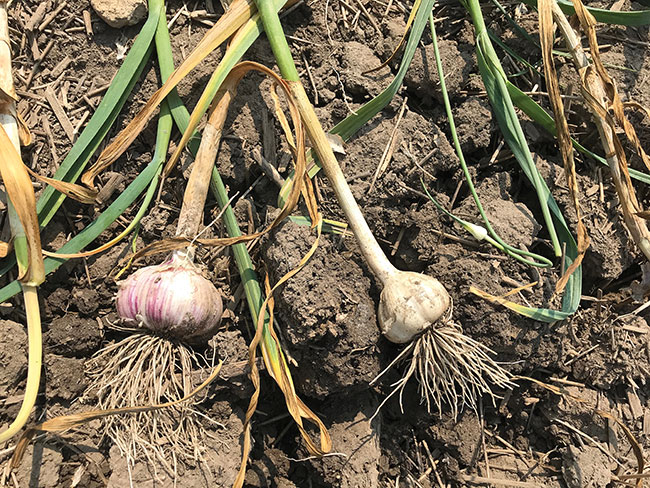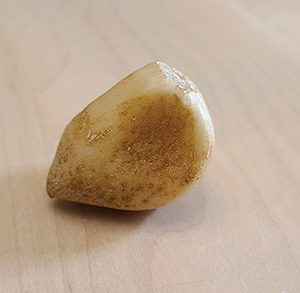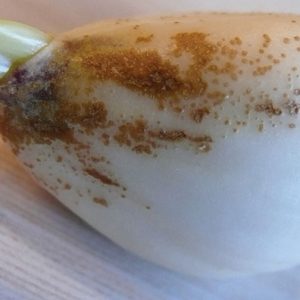
Features
Pest Management
Small but mite-y
Garlic mites have been mighty inconvenient this year, but they’re also indicative of larger-scale issues in garlic-growing.
February 16, 2022 By Alex Barnard
 Garlic mites were more prevalent during the 2021 season due to the extremely wet, humid periods during harvest and curing, creating favourable conditions for the mites in storage.
All photos courtesy of Travis Cranmer, OMAFRA.
Garlic mites were more prevalent during the 2021 season due to the extremely wet, humid periods during harvest and curing, creating favourable conditions for the mites in storage.
All photos courtesy of Travis Cranmer, OMAFRA. Have you noticed your stored garlic shrinking and developing brown spots? You might have garlic mites.
Travis Cranmer, vegetable crop specialist (Brassicas, Alliums and leafy vegetables) with the Ontario Ministry of Agriculture, Food and Rural Affairs (OMAFRA), says these mites have been more prevalent this year due to the extremely wet, humid periods during harvest, especially during curing – creating favourable conditions for the mites.
The pest most likely to be causing the lesions is known as the Acarid bulb mite, which lives between the papery layers on the clove. They are present in the soil and hitch a ride on the bulb when it is put in storage or overwinter on fall-planted garlic or crop debris. The mites can survive during the growing season on other crops, including corn, grains, Brassicas, or grassy cover crops.
“These Acarid mites are the ones taking a bite out of the clove, and these bites end up leading to the scars that we’re seeing,” Cranmer says.
While a bulb’s edibility is not affected by this scarring – cutting off the affected area is adequate for anyone concerned by the spots – marketability decreases quickly due to the visible marks and shrunken cloves from lost moisture.
Acarid mite feeding also increases the risk of damage from two pathogens often found in garlic storage – Fusarium and penicillium green mould. Mites and these pathogens can act in combination in storage to increase the rate of moisture loss from individual cloves in a bulb or an entire bulb compared to the surrounding bulbs.
As the damage happens between the papery layers and can’t be seen without cracking open the bulb, garlic mites are not the easiest pest to scout for in storage. Cranmer says growers can check for the presence of these pathogens by selecting bulbs from the bottom and middle of their stored garlic every month or so to test that they’re still firm. The loss of moisture caused by the pathogens means the cloves shrink beneath the papery covering, so an affected clove will yield a small amount of space when pressed.
Deep-seeded issues
One of the major challenges with growing garlic is the nature of how garlic is planted. The “seed” portion that is planted in the fall is actually the cloves, or bulbils, from previously harvested garlic bulbs.
“Garlic has a lot of problems with [pests and] pathogens because [they’re] building up over time,” Cranmer says. “That clove is from the mother plant, so all of the problems that were in that mother plant are now in the daughter plant, and every generation it builds up.”
This propagation method also cuts into the revenue earned from a garlic harvest, as one-fifth or one-sixth of the crop is kept in order to seed the following year. Competition from foreign garlic imports that sell for around $2 per pound also puts pressure on local growers, who have to charge at least $4 per pound to be economically viable.
So, with these challenges, why grow garlic?
“Because I think it’s one of the few commodities where we see someone with very little acreage get into the market and be profitable,” Cranmer says. “So, if you were to grow one acre and you had your own labor at your disposal, and you’re able to sell that crop for $10 a pound by selling through farmers’ markets, or directly to restaurants or the consumer and garlic festivals – you’re able to get $10 a pound, for Music and other rare varieties you might get $15 or $20 – there’s a lot of growers that rely on this model.”
There are limits to how large a grower can size up before the crop ceases to be profitable in the same way, though.
“A lot of stuff has to be done by hand, whether it’s planting, cracking or harvesting. And as you start to mechanize, costs add up, and then you have a huge crop and you can’t sell it in the same way as you were selling it before. So, you’re unable to sell for that $10 a pound,” Cranmer adds.
“You’re selling wholesale and that’s where it gets a little bit trickier. But as for getting into the market – it’s not like you can start with one acre of broccoli and be profitable, you need 50 to 100 acres of broccoli to start to become profitable. Whereas with garlic, you can start at a quarter of an acre and move your way up.
“Garlic is a relatively easy crop to grow, but once you grow it on a mass scale, pests and pathogens just infect everything and then it becomes difficult.”
Good in, good out
Focusing on how to improve storage conditions is important but might be putting the cart before the horse.
“The best thing to do before you even think about storing is curing. I feel like this step is underappreciated,” Cranmer says, highlighting the importance of shortening the curing period (72 hours or less is ideal) through removing moisture from the air and reducing humidity. He says this can be done with dehumidifiers or even air conditioners, but the progressive nature of harvest over days and weeks means that the first pallet of garlic harvested will likely go through a longer curing period than those harvested later, as the ambient humidity of the curing room will likely rise when a new pallet – and air from outside – is added.
Dehumidifiers and air conditioners, especially on the scale that would help cure a garlic harvest quickly, are expensive and not an option for every operation. Drying the garlic outdoors or in a greenhouse are also not advisable, with high humidity or wet weather and accidentally cooking the garlic as the respective obstacles.
When it comes to storing garlic, Cranmer ascribes to the philosophy of getting out what you put in. “You put quality [garlic] into storage, you get quality out; if you put in crap, it’s not going to store,” he says.
There are two ideal temperature ranges for garlic storage – -1 C to 1 C and 15 C to 18 C – and each has its benefits and detractors.
“If you put in a quality crop at either of those temperatures it’s going to keep, because those storage pathogens have been quashed right off the get-go,” Cranmer says.
While garlic stored at -1 C to 1 C might be less affected by pests like garlic mites and diseases, its storage quality when moved from those cold conditions to room temperature deteriorates rapidly and the garlic must be used within a short timespan. Garlic stored at 15 C to 18 C may be more susceptible to pests but, as the temperature change between storage and store shelves is lower, the garlic will last longer with the consumer.
Management options
Much like the “good in, good out” reality of garlic storage, planting garlic bulbils that aren’t infested with garlic mites is the best strategy to avoid continuing issues with the pest. However, there are currently no insecticides or miticides registered in Canada for control of mites on garlic.
Cranmer and his predecessors have worked on developing a clean seed program for garlic over the past several years, partnering with the University of Guelph’s New Liskeard Agricultural Research Station’s Seed Potato Upgrade and Distribution (SPUD) Unit to propagate virus- and pathogen-free garlic seed for growers. However, demand far outstrips the availability of clean seed at the moment, so Cranmer says basing management strategies on pathogen-free seed is “setting up a standard that doesn’t exist.”
Beyond shortening curing time to limit the pathogens that can proliferate in storage, Cranmer suggests crop rotation as an option to manage garlic mite populations. Legumes, carrots, beets, leafy greens or Solanaceae crops – such as tomatoes, eggplant, peppers or potatoes – are good choices for this purpose.
For growers who are interested in learning more about garlic, Cranmer recommends joining the closest growers association – for Ontario growers, that would be the Garlic Growers Association of Ontario.
Print this page

